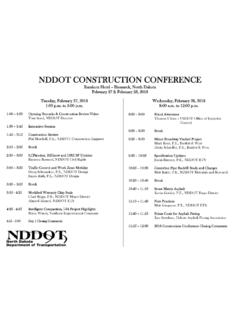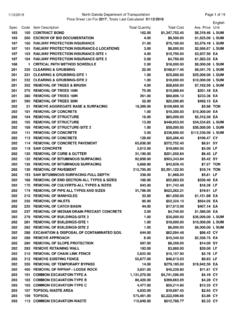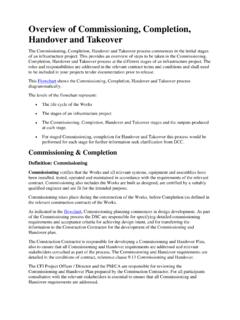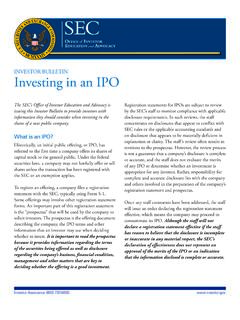Transcription of Overview of the System Engineering Process
1 Overview of the System Engineering Process Prepared by Ed Ryen, PE Maintenance ITS March 2008 23 CFR Project implementation. (a) All ITS projects funded with highway trust funds shall be based on a systems Engineering analysis. (b) The analysis should be on a scale commensurate with the project scope. (c) The systems Engineering analysis shall include, at a minimum: (1) Identification of portions of the regional ITS architecture being implemented (or if a regional ITS architecture does not exist, the applicable portions of the National ITS Architecture); (2) Identification of participating agencies roles and responsibilities ; (3) Requirements definitions; (4) Analysis of alternative System configurations and technology options to meet requirements; (5) Procurement options; (6) Identification of applicable ITS standards and testing procedures; and (7) Procedures and resources necessary for operations and maintenance Introduction This document provides a high level look at the Systems Engineering Process for ITS projects.
2 More detailed information of the System Engineering Process is available through FHWA s publication, System Engineering for Intelligent Transportation Systems . The systems Engineering should be viewed as an extension to the traditional project development Process that is already established in the department. As the NDDOT gains experience with ITS projects and the systems Engineering approach, we will find that we can weave the systems Engineering processes and best practices into our overall project development Process . What is Systems Engineering ? Since the term was coined in the 1950s, systems Engineering has evolved from a Process focused primarily on large-scale defense systems to a broader discipline that is used in all kinds of project development. Systems Engineering can be applied to any System development, so whether you are developing a household appliance, building a house, or implementing a sophisticated transportation management System , systems Engineering can be used.
3 INCOSE defines systems Engineering like this: Systems Engineering is an interdisciplinary approach and means to enable the realization of successful systems. It focuses on defining customer needs and required functionality early in the development cycle, documenting requirements, then proceeding with design synthesis and System validation while considering the complete problem. Systems Engineering integrates all the disciplines and specialty groups into a team effort forming a structured development Process that proceeds from concept to production to operation. Systems Engineering considers both the business and the technical needs of all customers with the goal of providing a quality product that meets the user needs. Note that this definition is very broad it covers the project life cycle from needs definition to System disposal.
4 It includes technical activities like requirements and design, as well as project activities like risk management and configuration management. Systems Engineering provides a systematic Process and tools that directly support project management. What is an ITS Project? In order to apply systems Engineering to ITS projects in accordance with the FHWA Rule/FTA Policy, it is important to define an ITS project. Rule 940 defines ITS projects quite broadly: ITS Project means any project that in whole or in part funds the acquisition of technologies or systems of technologies that provide or significantly contribute to the provision of one or more ITS user services as defined in the National ITS Architecture. This definition encompasses a wide range of projects. Smaller ITS projects might be limited to the purchase and installation of field equipment controllers, environmental sensors, signals, etc.
5 Larger ITS projects support integration of multiple systems and development of custom software for example, transportation management centers (TMC s) and 511 traveler information systems. These ITS projects are vastly different in complexity and in the amount of systems Engineering that is needed. The FHWA Division/FTA Regional Offices establish and monitor how systems Engineering analysis requirements are levied on specific ITS projects. Systems Engineering Principles Start with Your Eye on the Finish Line You should reach consensus at the very beginning of the project on what will constitute success at the end. This means that the stakeholders should start with an agreement of what the project should accomplish and the metrics that will be used to measure the success of the project.
6 This initial focus on the finish line must be sustained by project management as project development progresses and competing interests and project complexities begin to dominate the day-to-day work. Stakeholder Involvement is Key Successful projects involve the customer, users, operators, and other stakeholders in the project development. Systems Engineering is a systematic Process that includes reviews and decision points intended to provide visibility into the Process and encourage stakeholder involvement. The systems Engineering Process includes stakeholders through all stages of the project, from initial needs definition through System verification and acceptance. The stakeholders who are involved in any particular step will vary, providing managers, operators, and technical personnel with an opportunity to contribute to the steps in the Process where their input is needed.
7 The V Systems Engineering Model Many different Process models have been developed over the years that specify a series of steps that make up the systems Engineering approach6. Among these models, the V model, shown in Figure 7, is merging as the de facto standard way to represent systems Engineering for ITS projects. Don t be surprised if you come across different spellings for the V model. Some books, guides, and other resources refer to the same V-shaped model as the Vee model. If it looks like a V and it sounds like a V , then it is a reference to the same basic model, whether it is spelled V or Vee . Since it was first developed in the 1980s, the V model has been refined and applied in many different industries. Wings have been recently added to the V as part of its adaptation for ITS to show how project development fits within the broader ITS project life cycle.
8 The left wing shows the regional ITS architecture, feasibility studies, and concept exploration that support initial identification and scoping of an ITS project based on regional needs. A gap follows the regional architecture(s) step because the regional architecture is a broader product of the planning Process that covers all ITS projects in the region. The following steps in the V are for a specific ITS project. The central core of the V shows the project definition, implementation, and verification processes. The right wing shows the operations and maintenance, changes and upgrades, and ultimate retirement of the System . The wings are a key addition to the model since it is important to consider the entire life cycle during project development. What are the Parts of the V Diagram Using the Regional ITS Architecture In this step: The portion of the regional ITS architecture that is related to the project is identified.
9 Other artifacts of the planning and programming processes that are relevant to the project are collected and used as a starting point for project development. This is the first step in defining your ITS project. OBJECTIVES Define the project scope while considering the regional vision and opportunities for integration Improve consistency between ITS projects and identify more efficient incremental implementation strategies Improve continuity between planning and project development INPUT Sources of Information Relevant regional ITS architecture(s) Regional/national resources supporting architecture use Other planning/programming products relevant to the project Process Key Activities Identify regional ITS architecture(s) that are relevant to the project Identify the portion of the regional ITS architecture that applies Verify project consistency with the regional ITS architecture and identify any necessary changes to the regional ITS architecture OUTPUT Process Results List of project stakeholders and roles and responsibilities List of inventory elements included in or affected by the project List of requirements the proposed System (s) must meet List of interfaces and the information to be exchanged or shared by the System (s) Regional ITS architecture feedback as necessary REVIEW Proceed only if you have.
10 Demonstrated consistency with the regional ITS architecture and identified needed changes to the regional ITS architecture, if applicable Extracted the relevant portion of the regional ITS architecture that can be used in subsequent steps Reached consensus on the project/ System scope Overview The regional ITS architecture provides a good starting point for systems Engineering analyses that are performed during ITS project development. It provides region-level information that can be used and expanded in project development. When an ITS project is initiated, there is a natural tendency to focus on the programmatic and technical details and to lose sight of the broader regional context. Using the regional ITS architecture as a basis for project implementation provides this regional.

















